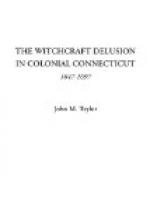“About the buisnes of fliing the most part thought it was not legally proued.
“Lastly the woman and Robert Stern being boath upon oath their wittnes was judged legall testimony ore evidence only som in the jury because Sternes first words upon his oath were, I saw these women and as I take it goody Seger was there though after that he sayd, I saw her there, I knew her well I know God will require her blood at my hands if I should testifie falsly. Allso bec he sd he saw her kittle, there being at so great a distance, they doubted that these things did not only weaken & blemish his testimony, but also in a great measure disable it for standing to take away liffe.”
“WALT. FYLER.”
Elizabeth Seager was acquitted.
ELIZABETH GODMAN
Of all the women who set the communities ablaze with their witcheries, none in fertility of invention and performance surpassed Elizabeth Godman of New Haven—a member of the household of Stephen Goodyear, the Deputy Governor. Reverend John Davenport said, in a sermon of the time, “that a froward discontented frame of spirit was a subject fitt for ye Devill,” and Elizabeth was accused by Goodwife Larremore and others of being in “such a frame of spirit,” and of practicing the black arts.
She promptly haled her accusers before a court of magistrates, August 4, 1653, with Governor Theophilus Eaton and Deputy Governor Stephen Goodyear present; and when asked what she charged them with, she desired that “a wrighting might be read—wch was taken in way of examination before ye magistrate,” in May, 1653. The “wrighting” did not prove helpful to Elizabeth’s case. The statements of witnesses and of the accused are in some respects unique, and of a decided personal quality.
"Hobbamocke”—The “swonding fitt”—Lying—Evil communications—The Indian’s statement—“Ye boyes sickness”—“Verey strang fitts”—“Figgs”— “Pease porridge”—“A sweate”—Mrs. Goodyeare’s opinion—Absorption— Contradictions—Goodwife Thorp’s chickens—“Water and wormes"




